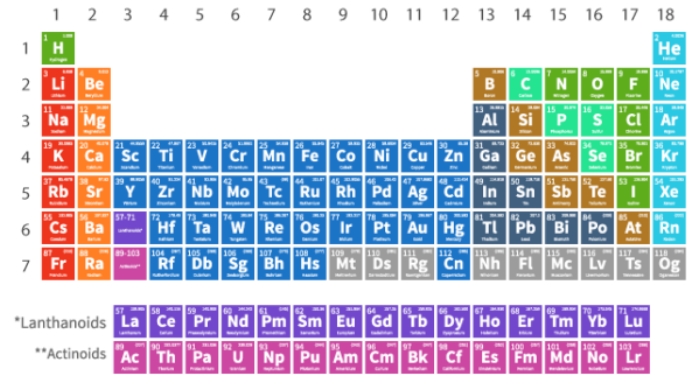

NCERT Solutions for Class 10 Science Chapter 5: In accordance with CBSE rules, NCERT Solutions for Class 10 Science Chapter 5 - Periodic Classification of Elements offers comprehensive answers to every question.
The NCERT solutions have been prepared by subject-matter specialists in accordance with the comprehension level of Class 10 pupils, and they correspond with the problems presented in the NCERT textbook. The NCERT textbook has been thoughtfully crafted to enable students to get comprehensive understanding of the subject matter.
Class 10 Science Chapter 5 Periodic Classification of Elements
Chapter 5 of NCERT Class 10 Science, Periodic Classification of Elements, explains the historical development and modern approach to the classification of elements. The chapter begins with the early attempts at classification, including Dobereiner’s Triads and Newlands' Law of Octaves, discussing their limitations.It then introduces Mendeleev’s Periodic Table, explaining how he arranged elements based on increasing atomic mass and properties, and how he left gaps for undiscovered elements. The modern periodic table is discussed next, based on the increasing atomic number, with a focus on how elements are arranged into groups and periods. The periodic trends in properties, such as valency, atomic size, metallic and non-metallic character, are thoroughly explained.
NCERT Solutions for Class 10 Science Chapter 5 PDF
The chapter provides a strong understanding of how elements are organized, helping students understand chemical behavior and trends in a structured way. Hence, here we have provided NCERT Solutions for Class 10 Science Chapter 5 Periodic Classification of Elements pdf -NCERT Solutions for Class 10 Science Chapter 5 PDF
NCERT Solutions for Class 10 Science Chapter 5 Periodic Classification of Elements
Below we have provided NCERT Solutions for Class 10 Science Chapter 5 Periodic Classification of Elements -1. Did Döbereiner’s triads also exist in the columns of Newlands’ Octaves? Compare and find out.
Solution:
Döbereiner’s triads did exist in the columns of Newlands’ Octaves; For example, the elements Lithium (Li), Potassium (K) and Sodium (Na) constitute a Dobereiner’s Triad but are also found in the second column of Newland’s Octaves.2. What were the limitations of Döbereiner’s classification?
Solution:
(i) Neither very low mass nor very high mass elements could use them. (ii) Dobereiner's triads could not include all of the components. (iii) The validity of Dobereiner's triads started to wane as techniques for calculating atomic mass advanced. For instance, the atomic mass of CI is not equal to the arithmetic mean of the atomic masses of F and Br in the trio of F, Cl, and Br.3. What were the limitations of Newlands’ Law of Octaves?
Solution:
The following are Newlands' Law of Octaves' limitations:- Applying Newlands' Law of Octaves to elements up to Calcium only Newland made the assumption that there were already 56 elements in nature and that no more would be found in the future.
- Newland inserted two items into a single slot in order to fit them into the table. Newland combined dissimilar items with various attributes into a single column.
- Iron (Fe) was kept apart from substances with similar characteristics. Ex: Cobalt and nickel
Questions Page number 85
1. Use Mendeleev’s Periodic Table to predict the formulae for the oxides of the following elements: K, C, AI, Si, Ba.

Solution:
K- K 2 O C-C 2 O 4 or CO 2 Al- Al 2 O 3 Si-Si 2 O 4 or SiO 2 Ba 2 O 2 or BaO Oxygen is a member of group VI A in Mendeleev’s periodic table. Its valency is 2. Similarly, the valencies of all the elements listed can be predicted from their respective groups. This will help in writing the formulae of their oxides. (i) Potassium (K) is a member of group IA. Its valency is 1. Therefore, its formula is K 2 O. (ii) Carbon (C) is a member of group IV A. Its valency is 4. Therefore, the formula is C 2 O 4 or CO 2 . (iii) Aluminium (Al) belongs to groups III A and its valency is 3. The formula of its oxide is Al 2 O 3 . (iv) Silicon (Si) is present in group IV A after carbon. Its valency is also 4. The formula of oxide is Si 2 O 4 or SiO 2 . (v) Barium (Ba) belongs to group II A and the valency of the element is 2. The formula of the oxide of the element is Ba 2 O 2 or BaO.2. Besides gallium, which other elements have since been discovered that were left by Mendeleev in his Periodic Table? (Any two)
Solution:
Germanium and Scandium are the elements that are left by Mendeleev in his Periodic Table since its discovery.3. What were the criteria used by Mendeleev in creating his Periodic Table?
Solution:
Mendeleev focused on the different compounds that elements containing hydrogen and oxygen could form. When constructing his periodic table, he took note of the link between the atomic masses of different elements in addition to other physical characteristics.4. Why do you think the noble gases are placed in a separate group?
Solution:
Because they are inert and present in small amounts in our environment, noble gases are categorised under a different group. To prevent them from upsetting the current order, they are housed in a distinct group known as the Zero group.Questions Page number 90
1. How could the Modern Periodic Table remove various anomalies of Mendeleev’s Periodic Table?
Solution:
(a) Elements are grouped in the Modern Periodic Table according to increasing atomic number. This eliminates the irregularity pertaining to specific element pairs in Mendeleev's periodic table. (b) Cobalt has an atomic number of 27, while nickel has a number of 28. Because of this, cobalt will arrive before nickel despite having a larger atomic mass. c) The contemporary periodic table arranges all isotopes of the same element in the same position because they have different atomic masses but the same atomic number.2. Name two elements you would expect to show chemical reactions similar to magnesium. What is the basis for your choice?
Solution:
Calcium and Beryllium are similar to Magnesium because all three elements belong to the same group and have 2 valence electrons in their outer shell.3. Name
(a) Three elements that have a single electron in their outermost shells.
(b) Two elements that have two electrons in their outermost shells.
(c) Three elements with filled outermost shells
Solution:
- Lithium (Li), Sodium (Na) and potassium (k) have a single electron in their outermost shells.
- Magnesium (Mg) and Calcium (Ca) have two electrons in their outermost shells
- Neon (Ne), Argon (Ar and Xenon (Xe) filled outermost shells
4. a) Lithium, sodium, and potassium are all metals that react with water to liberate hydrogen gas. Is there any similarity in the atoms of these elements?
(b) Helium is an unreactive gas and neon is a gas of extremely low reactivity. What, if anything, do their atoms have in common?
Solution:
They are extremely unstable because they only have one valence electron in their outermost shells. Thus, they react with water easily to release hydrogen. Another name for them is alkali metals. High stability results from the fullness of their outermost shells. They are referred to be noble gases because they only react under very specific conditions.5. In the Modern Periodic Table, which are the metals among the first ten elements?
Solution:
Lithium and Beryllium are the metals among the first ten elements in the Modern Periodic Table.6. By considering their position in the Periodic Table, which one of the following elements would you expect to have maximum metallic characteristic? Ga Ge As Se Be
Solution:
Among the elements listed in the question. Be and Ga are expected to be the most metallic. Out of Be and Ga, Ga is bigger in size and hence has a greater tendency to lose electrons than Be. Therefore, Ga is more metallic than Be.Exercise questions Page number 91-92
1. Which of the following statements is not a correct statement about the trends when going from left to right across the periods of Periodic Table.
(a) The elements become less metallic in nature.
(b) The number of valence electrons increases.
(c) The atoms lose their electrons more easily.
(d) The oxides become more acidic
Solution:
The atoms lose their electrons more readily, hence option (c) is the right response. The claim that atoms lose their electrons more readily is false because the non-metallic nature of atoms increases as we move from left to right throughout the periodic table. As a result, there is less of a tendency to lose an electron.2. Element X forms a chloride with the formula XCl 2 , which is a solid with a high melting point. X would most likely be in the same group of the Periodic Table as (a) Na (b) Mg (c) AI (d) Si
Solution:
The answer is Magnesium because Mg has the valency 2, which is the same as the group (a) Na (b) Mg (c) AI (d) Si Also, Mg, when combined with chloride, forms MgCl 2 .3. Which element has?
(a) Two shells, both of which are completely filled with electrons?
(b) The electronic configuration 2, 8, 2?
(c) A total of three shells, with four electrons in its valence shell?
(d) A total of two shells, with three electrons in its valence shell?
(e) twice as many electrons in its second shell as in its first shell?
Solution:
a) Neon has two shells which are completely filled. b) Magnesium has electronic configuration 2, 8, 2 c) Silicon has a total of three shells, with four electrons in its valence shell d) Boron has a total of two shells, with three electrons in its valence shell e) Carbon has twice as many electrons in its second shell as in its first shell4. (a) What property do all elements in the same column of the Periodic Table as boron have in common?
(b) What property do all elements in the same column of the Periodic Table as fluorine have in common?
Solution:
(a) Group 13 includes all elements that are in the same column as boron. They each have three electrons in their valence shell as a result. All of the elements in this group—aluminum, gallium, indium, and thallium—apart from boron, which is a non-metal. (b) All elements in group thirteen of the Periodic Table that are located in the same column as fluorine share three electrons in their valence shell.5. An atom has electronic configuration 2, 8, 7.
(a) What is the atomic number of this element?
(b) To which of the following elements would it be chemically similar? (Atomic numbers are given in parentheses.) N(7), F(9), P(15), Ar(18)
Solution:
(a)The element with electronic configuration (2+8+7) 17 is chlorine. The no. of atomic number = no. of electrons Therefore, the atomic number is 17. (b) An atom with electronic configuration 2, 8, 7 would be chemically similar to F (9)6. The position of three elements A, B and C in the Periodic Table are shown below–
Group 16 Group 17
– –
– A
– –
B C
(a) State whether A is a metal or non-metal.
(b) State whether C is more reactive or less reactive than A.
(c) Will C be larger or smaller in size than B?
(d) Which type of ion, cation or anion, will be formed by element A?
Solution:
- Element A is a non-metal
- Element C is less reactive than Element A
- C is smaller in size than B
- A will form anion
7. Nitrogen (atomic number 7) and phosphorus (atomic number 15) belong to group 15 of the Periodic Table. Write the electronic configuration of these two elements. Which of these will be more electronegative? Why?
Solution:
The atomic number of Nitrogen is 7 hence Electronic configuration of Nitrogen is 1s 2 2s 2 2p 3 The atomic number of Nitrogen is 15 hence Electronic configuration of Phosphorous is 1s 2 2s 2 2p 6 3s 2 3p 3 As one moves down a group in the periodic table, one encounters more shells. As a result, the effective nuclear charge drops and the valence electrons separate from the electrons. As a result, there is less of an inclination to attract electrons, which lowers electro negativity. Nitrogen is more electronegative than phosphorus for all of the aforementioned reasons.8. How does the electronic configuration of an atom relate to its position in the Modern Periodic Table?
Solution:
An atom's location in the periodic table is determined by its number of valence electrons, whereas the number of valence electrons is determined by its electronic configuration.9. In the Modern Periodic Table, calcium (atomic number 20) is surrounded by elements with atomic numbers 12, 19, 21 and 38. Which of these have physical and chemical properties resembling calcium?
Solution:
Calcium has an electrical configuration of 2, 8, 8, 2, according to its atomic number of 20. Calcium therefore has two valence electrons. The element with atomic number 12 has an electrical configuration of 2, 8.2. Thus, calcium is the element that closest resembles this one with two valence electrons.10. Compare and contrast the arrangement of elements in Mendeleev’s Periodic Table and the Modern Periodic Table.
Solution:
| Mendeleev’s Periodic Table | Modern Periodic Table |
| Elements are arranged in the increasing order of their atomic masses. | Elements are arranged in the increasing order of their atomic numbers. |
| There are 8 groups | There are 18 groups |
| Each group is subdivided into sub-groups ‘a’ and ‘b’ | Groups are not subdivided into sub-groups. |
| Groups for Noble gases were not present as noble gases were not discovered by that time | A separate group is meant for noble gases. |
| There was no place for isotopes. | This problem has been rectified as slots are determined according to atomic number. |
Benefits of NCERT Solutions for Class 10 Science Chapter 5
NCERT Solutions for Class 10 Science Chapter 5, Periodic Classification of Elements , offer several key benefits to students:Conceptual Understanding : The NCERT Solutions for Class 10 Science Chapter 5 simplify complex topics such as periodic trends, atomic size, and classification methods, helping students grasp these concepts with ease.
Clarification of Historical Developments : The NCERT Solutions for Class 10 Science Chapter 5 explain the evolution of element classification from Dobereiner’s Triads to the modern periodic table, enhancing students' appreciation of the scientific process.
Systematic Learning : The NCERT Solutions for Class 10 Science Chapter 5 follow the NCERT textbook pattern, providing a systematic approach to learning, which helps students understand how elements are organized and why.
Easy Problem Solving : Detailed solutions for exercises help students solve both theoretical and numerical problems effectively, reinforcing their understanding of the chapter.
Better Exam Preparation : By aligning with the CBSE syllabus, the solutions provide accurate and comprehensive answers, aiding in better preparation for board exams.
NCERT Solutions for Class 10 Science Chapter 5 FAQs
What is the periodic classification based on?
What is the need for periodic classification?
What is the basis for the periodic classification of elements?
What is the theory of periodic classification of elements?












